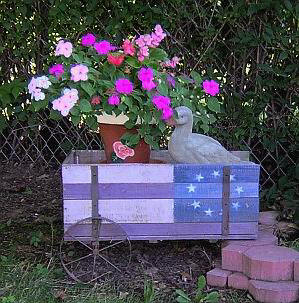 Growing plants in containers is currently one of the fastest growing gardening activities. Container gardens bring you the rewards of gardening whether you have a
small space or a large landscape. Gardening in containers can be satisfying for beginning gardeners as well experienced ones because it is easy, fun, economical, fast, compact and versatile. It offers an opportunity to allow your imagination and creative side to run wild.
As with all types of gardening, there are some basic guidelines to follow when planting in containers. Following these simple concepts will make for successful results in your container gardening. Always keep in mind that container plants are more dependent on the gardener
for their basic needs of proper soil, proper light, sufficient light, shelter from extreme heat or cold, and pest control.
Growing plants in containers is currently one of the fastest growing gardening activities. Container gardens bring you the rewards of gardening whether you have a
small space or a large landscape. Gardening in containers can be satisfying for beginning gardeners as well experienced ones because it is easy, fun, economical, fast, compact and versatile. It offers an opportunity to allow your imagination and creative side to run wild.
As with all types of gardening, there are some basic guidelines to follow when planting in containers. Following these simple concepts will make for successful results in your container gardening. Always keep in mind that container plants are more dependent on the gardener
for their basic needs of proper soil, proper light, sufficient light, shelter from extreme heat or cold, and pest control.
Containers
 The containers are as important as the selection of plants they will hold. Containers come in a variety of sizes, shapes and materials. What you choose will depend upon the types of plants and the locations. As you design your container garden,
consider that weight might be a major factor when the containers are filled with soil. Containers should be large enough to give plants plenty of space for healthy growth. The sizes and shapes of containers are best chosen based on the variety or size of plants you want to
grow in them. Make sure they have at least one drainage hole in the bottom to prevent rot. Be sure to thoroughly clean any containers that were used for previous plants, as this prevents diseases from attacking new plants. Use any containers you want or can find. We may
think of wooden barrels, terra cotta, and plastic or glazed pots as the only kinds of containers; however, if they hold soil, they are containers. Go ahead, get creative with your containers or pots; you are only limited by your imagination.
The containers are as important as the selection of plants they will hold. Containers come in a variety of sizes, shapes and materials. What you choose will depend upon the types of plants and the locations. As you design your container garden,
consider that weight might be a major factor when the containers are filled with soil. Containers should be large enough to give plants plenty of space for healthy growth. The sizes and shapes of containers are best chosen based on the variety or size of plants you want to
grow in them. Make sure they have at least one drainage hole in the bottom to prevent rot. Be sure to thoroughly clean any containers that were used for previous plants, as this prevents diseases from attacking new plants. Use any containers you want or can find. We may
think of wooden barrels, terra cotta, and plastic or glazed pots as the only kinds of containers; however, if they hold soil, they are containers. Go ahead, get creative with your containers or pots; you are only limited by your imagination.
Medium/Soil
Soil to be used in containers should contain plenty of organic matter. Garden or yard soil is very dense, holds water, doesn’t contain enough nutrients, and excludes oxygen that roots need for growth. A good medium or potting soil must be porous in
order to support plants because roots require both air and water. A porous soil mixture from the local garden center should work well.
Plants
There are few plants that cannot be grown in suitably sized containers. Don’t limit yourself to a few common annuals and tender perennials. Experiment. If all you have is a shady spot, then use containers full of ferns, hostas, camellias, pieris,
fuchsias and impatiens. If you want an edible garden, almost any vegetable or fruit will adapt to containers: tomatoes, peppers, strawberries or blueberries. Use several varieties of flowers and foliages in pleasing combinations of color and texture. Design the container
plantings for shade or sun, combining only those plants with similar cultural requirements. Make sure the containers are large enough and the surfaces where they are placed are sturdy enough to withstand the containers’ weight. When planting, combine a variety of plants.
Annuals, perennials, herbs, small trees and vegetables all work well. Consider the growing patterns of plants. Some are sprawlers, some make good fillers and some grow upright. Some form clusters and others trail down the sides of the containers. Keep in mind colors and
both the size of the plants and the size of their flowers. Look to strike a happy balance with all these variables. Remember, you are the designer and you can put in your containers whatever you wish to see.
Planting
Now that you’ve gathered bags of potting soil, purchased plants and selected containers, you’re ready to plant. The first step is to place sufficient drainage material in the bottom of each container so water can pass through freely. Above the
drainage, spread a layer of soil and place the plants in position so that the surface of the soil will be an inch or two below the rim of the container. This space is needed to hold water. Fill soil in around the roots of the plants, firming gently with your fingers to
eliminate air pockets. Add more soil and firm and finally water plants well.
Maintenance
Plants in containers are dependent on gardeners for their basic needs. They need regular attention to look their best. The real challenge with container gardens is the watering. Container grown plants tend to dry out quickly and at times under
certain conditions may need a drink every single day. Though it is essential to give enough water, it is equally important not to over water to prevent root rot. They also need fertilizer frequently because nutrients may leach out of the soil each time you water. Use
water-soluble products, time-released or slow release fertilizers and compost to help add nutrients. Periodically, prune dead blooms and leggy foliage. Pruning can rejuvenate older plants as the growing season progresses. When the plants begin to look tired and past their
prime, pull them out and replace them with fresh plants such as kale, pansies and mums for seasonal autumn color.
The possibilities for container gardening are endless and limited only by your imagination. It can be as simple as the petunias on the front porch or as elaborate as an entire patio garden – it’s all up to your personal preference. Grab your
containers, roll up your sleeves, get your hands dirty, and start your container gardens.
Read other articles on plants and gardens
Read other articles by Liz Miller